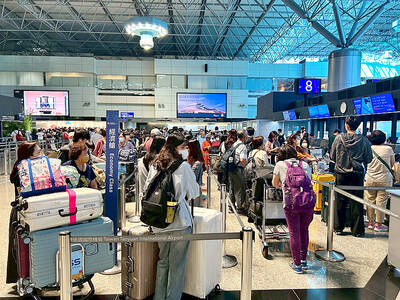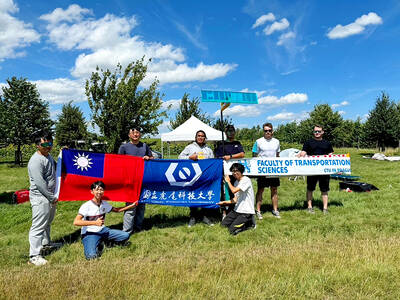Images of a speeding ticket for a fighter jet that took off from an emergency runway on a freeway during the Han Kuan military exercises last week were doctored, the National Highway Police Bureau said on Sunday.
Two versions of the traffic citation — supposedly issued by the highway police — showed stills from traffic cameras on the Sun Yat-sen Freeway (Freeway No. 1).
One purportedly showed a traffic camera image of an Indigenous Defense Fighter on the Changhua Reserve Runway exceeding the 110kph speed limit by 240kph.

Photo: Screen grab from Line app
The other showed four grainy images of a military aircraft taking off from a freeway and said the cameras were located between the 230km and 650km markers on the Puyan Interchange (埔鹽).
Netizens said they suspected the images were fakes, adding that the military would have removed traffic cameras from emergency runways as potential hazards prior to the exercise.
The Third Brigade of the National Highway Police issued a statement saying that the images were fake.
The emergency runway ran from the 204km to 207km markers of Freeway No. 1, not the 230km to 650km markers, and did not have any traffic cameras to begin with, the highway police said.
Whoever created the images did not tamper with official traffic tickets, so no charges are being considered, they added.

The Chinese military has built landing bridge ships designed to expand its amphibious options for a potential assault on Taiwan, but their combat effectiveness is limited due to their high vulnerability, a defense expert said in an analysis published on Monday. Shen Ming-shih (沈明室), a research fellow at the Institute for National Defense and Security Research, said that the deployment of such vessels as part of the Chinese People’s Liberation Army (PLA) Navy’s East Sea Fleet signals a strong focus on Taiwan. However, the ships are highly vulnerable to precision strikes, which means they could be destroyed before they achieve their intended

About 4.2 million tourist arrivals were recorded in the first half of this year, a 10 percent increase from the same period last year, the Tourism Administration said yesterday. The growth continues to be consistent, with the fourth quarter of this year expected to be the peak in Taiwan, the agency said, adding that it plans to promote Taiwan overseas via partnerships and major events. From January to June, 9.14 million international departures were recorded from Taiwan, an 11 percent increase from the same period last year, with 3.3 million headed for Japan, 1.52 million for China and 832,962 to South Korea,

SOVEREIGNTY: The rigs show that Beijing ‘rejects Taiwan’s jurisdiction’ by building in areas where Taipei demands permission to build or alter installations Chinese oil rigs have been sighted just 26 nautical miles (42km), from Taiwan’s exclusive economic zone (EEZ) near Pratas Island (Dongsha Island, 東沙島), posing a threat to Taiwan’s sovereignty if left unchallenged, a brief published by the Jamestown Foundation on Tuesday said. Pratas Island, 444km from Kaohsiung, is northeast of the South China Sea and houses a Taiwanese garrison. The brief, titled “Rigging the Game: PRC Oil Structures Encroach on Taiwan’s Pratas Island” — referring to the People’s Republic of China — analyzed photographs and said that Beijing’s tools to pressure Taiwan now include oil rigs. “Oil rigs now constitute part of Beijing’s

The Taiwan Experience Education Program (TEEP) has funded short-term internships in Taiwan for more than 4,500 young people from more than 40 countries since 2015, with the goal of attracting and retaining international talent, the Ministry of Education said yesterday. Fifty-five colleges launched 514 projects this year, including in fields such as semiconductors, artificial intelligence, medicine and biotechnology, green energy, and sustainability, it said. The program provides research and practical internships in Taiwan for two to six months, and offers cultural exchange and networking opportunities, the ministry said. For example, National Formosa University’s Embedded System and Autopilot Laboratory developed two solar-powered drones in